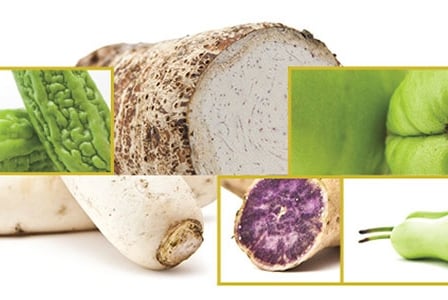
Tired of the same old peas and carrots on your plate? Our exotic vegetables such as the chayote and bitter gourd will add an international flavour to your meals.
With soup and stew season upon us, what better way to ramp up the flavour and nutritional content of your favourite recipes than by adding some exotic vegetables? These odd-looking but tasty travellers not only introduce a novel dimension to your everyday meals, but will also make dinner time an exciting time.
Storing root vegetables
- Cool, moist, and dark—these are the three things to remember for choosing the best storage conditions. Underneath the back porch is good, or if you have access to a cellar, even better.
- Try to keep the temperature around 50 to 60 F (10 to 12 C) in a relatively humid environment. Warmer temperatures can cause sprouting or rot; freezing will shorten shelf life. Don’t wash the vegetables before storing them.
- Store root vegetables in a box off the cellar floor. Contact with damp ground encourages rot. If you have the space, the crisper drawer in your refrigerator is another alternative.
- Do not store root vegetables with apples, as they give off ethylene gas and cause carrots to become bitter and potatoes to sprout.
Opo squash
Appearance
Opos and common zucchini are similar in texture and size, so be extra vigilant in the produce section. This Southeast Asian vegetable is typically used in Asian cuisine and is sometimes classified as a melon.
Health benefits
The opo squash is fat free and boasts a zero count of sodium and cholesterol. One serving of opo squash provides 24 percent of our recommended daily amount of vitamin C, which boosts our immune system and reduces inflammation. It is also a source of eye-protecting vitamin A and blood pressure-lowering potassium.
Taste
The opo’s mild taste makes it a versatile vegetable that instantly boosts the nutritional content of any dish. It hails from the cucumber family, so expect similar taste and texture.
Preparation tips
Pick smaller-sized opos for a lighter taste, larger sized for stronger. Spice it up and add it to Indian chutneys and curries, grate it into a salad, or chop it into cubes for the perfect addition to a flavourful Asian stir-fry.
Taro root
Appearance
The taro root is native to the South Pacific Islands. The tuber is light brown with uneven ridges, weighing 1 to 2 lb (450 g to 1 kg) and measuring up to 12 in (30 cm) long. The leaves and stalks of the plant are also edible.
Health benefits
Traditionally used as a medicine, taro root is high in complex carbohydrates and fibre, and low in fat. It is also a good source of vitamin C, which supports a strong immune system.
Taste
Taro is a little bland on its own, and is best used as a side dish, whether baked, boiled, or roasted. Mix it into your favourite stew for an added hit of fibre, or use it to infuse richness into a rice dish.
Preparation tips
Beware—eating raw taro, whether the tuber, the leaves, or the stem, is toxic and can cause uncomfortable itching in the mouth due to the presence of calcium oxalate crystals. Make sure to cook it properly.
Bitter gourd
Appearance
Don’t let the bitter gourd’s rough exterior put you off—the skin is edible! Bitter gourds, also known as bitter melons, typically measure 8 to 12 in (20 to 30 cm) in length and are light green in colour when ripe, turning yellow when mature. Inside, the flesh is similar to that of a cucumber.
Health benefits
Some hail the bitter gourd as a natural treatment for type 2 diabetes, though conclusive testing on humans has yet to be completed. Early test tube studies show that a protein found in bitter melon may also have an ability to kill viruses and slow the growth of some cancer cells.
Taste
Is bitter gourd really bitter? Well, yes. The bitterness comes from the seeds and pith inside the gourd, which must be removed before eating or cooking. The greener the gourd, the more bitter the taste.
Preparation tips
Slice bitter gourd in half and scrape out the seeds and pith. Blanching it in lightly salted boiling water will reduce some of the bitterness. Since bitter balances spicy, use bitter gourd in recipes that call for spiced meat, rich sauces, or fermented beans. It’s also great when chopped and thrown into an omelette.
Daikon radish
Appearance
This long and thin white vegetable could easily be mistaken for a giant pale carrot. An average daikon is 10 to 12 in (25 to 30 cm) long. Choose daikons with smooth, shiny skin and fresh roots. As with carrots, avoid daikons that are cracked or dried.
Health benefits
Daikons are low in calories and a source of vitamin C. The skin of the daikon is believed to contain naturally active enzymes that aid digestion.
Taste
This mild vegetable is traditionally used in Asian cuisine, either raw or marinated in vinegar. Its crunchiness and versatility lend themselves well to being grated into salads or added to stews. Cooked daikon is a common ingredient in miso soup.
Preparation tips
Shred a daikon and use it in a slaw, cube it and add to your pan-roasted vegetables, or slice it and add to your favourite smoothie recipe for a boost of vitamin C. Switch things up and use one as a substitute for carrot or radish in any recipe!
Chayote
Appearance
This exotic vegetable, also known as Mexican squash, is easily identified by its pear shape and bumpy skin, which varies from creamy white to pale green in colour. Chayotes contain a single seed that is about 1 to 2 in (2.5 to 5 cm) long. Mature fruit is 3 to 8 in (7.5 to 20 cm) long and weighs from 8 oz to 1 lb (225 to 450 g).
Health benefits
Low in sodium and full of fibre, this refreshing squash has only 40 calories per cup.
Taste
Inside is a crisp, pale flesh with a unique flavour that resembles a cross between an apple and a cucumber.
Preparation tips
Sautéed, baked, pickled, or stuffed, take your pick. Traditional Mexican recipes make use of the versatile chayote in soups, stews, salads, and even pies. It can also be tossed onto the grill.
Okinawan sweet potato
Appearance
You can definitely have some fun with this bright violet vegetable, which is used in a variety of Japanese and Hawaiian dishes. On the outside, it looks like any other tuber, but cut it open and you’ll marvel at the vibrant colour inside.
Health benefits
Sweet potatoes have a reputation for being nature’s perfect food—the Okinawan is no exception. High in vitamins A and B6, and minerals such as manganese and potassium, this particular tuber is also rich in anthocyanin, an antioxidant that gives it its purple colour.
Taste
Okinawans are on the sweeter side, without the usual carrotlike taste of other sweet potato varieties.
Preparation tips
Simply peel it and use as you would any other sweet potato. Be creative! The nutrient-packed flesh adds an unusual colour to any mashed or baked dish.



